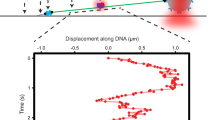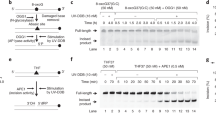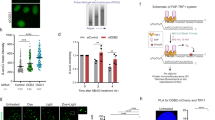Abstract
Alkyltransferase-like proteins (ATLs) share functional motifs with the cancer chemotherapy target O6-alkylguanine-DNA alkyltransferase (AGT) and paradoxically protect cells from the biological effects of DNA alkylation damage, despite lacking the reactive cysteine and alkyltransferase activity of AGT. Here we determine Schizosaccharomyces pombe ATL structures without and with damaged DNA containing the endogenous lesion O6-methylguanine or cigarette-smoke-derived O6-4-(3-pyridyl)-4-oxobutylguanine. These results reveal non-enzymatic DNA nucleotide flipping plus increased DNA distortion and binding pocket size compared to AGT. Our analysis of lesion-binding site conservation identifies new ATLs in sea anemone and ancestral archaea, indicating that ATL interactions are ancestral to present-day repair pathways in all domains of life. Genetic connections to mammalian XPG (also known as ERCC5) and ERCC1 in S. pombe homologues Rad13 and Swi10 and biochemical interactions with Escherichia coli UvrA and UvrC combined with structural results reveal that ATLs sculpt alkylated DNA to create a genetic and structural intersection of base damage processing with nucleotide excision repair.
This is a preview of subscription content, access via your institution
Access options
Subscribe to this journal
Receive 51 print issues and online access
$199.00 per year
only $3.90 per issue
Buy this article
- Purchase on Springer Link
- Instant access to full article PDF
Prices may be subject to local taxes which are calculated during checkout





Similar content being viewed by others
References
Pegg, A. E. Repair of O6-alkylguanine by alkyltransferases. Mutat. Res. 462, 83–100 (2000)
Tubbs, J. L., Pegg, A. E. & Tainer, J. A. DNA binding, nucleotide flipping, and the helix-turn-helix motif in base repair by O6-alkylguanine-DNA alkyltransferase and its implications for cancer chemotherapy. DNA Repair (Amst.) 6, 1100–1115 (2007)
Loechler, E. L., Green, C. L. & Essigmann, J. M. In vivo mutagenesis by O6-methylguanine built into a unique site in a viral genome. Proc. Natl Acad. Sci. USA 81, 6271–6275 (1984)
Pauly, G. T., Hughes, S. H. & Moschel, R. C. Comparison of mutagenesis by O6-methyl- and O6-ethylguanine and O4-methylthymine in Escherichia coli using double-stranded and gapped plasmids. Carcinogenesis 19, 457–461 (1998)
Margison, G. P. & Santibáñez-Koref, M. F. O6-Alkylguanine-DNA alkyltransferase: role in carcinogenesis and chemotherapy. Bioessays 24, 255–266 (2002)
Mitra, S. & Kaina, B. Regulation of repair of alkylation damage in mammalian genomes. Prog. Nucleic Acid Res. Mol. Biol. 44, 109–142 (1993)
Pegg, A. E., Dolan, M. E. & Moschel, R. C. Structure, function and inhibition of O6-alkylguanine-DNA alkyltransferase. Prog. Nucleic Acid Res. Mol. Biol. 51, 167–223 (1995)
Daniels, D. S. & Tainer, J. A. Conserved structural motifs governing the stoichiometric repair of alkylated DNA by O6-alkylguanine-DNA alkyltransferase. Mutat. Res. 460, 151–163 (2000)
Daniels, D. S. et al. Active and alkylated human AGT structures: a novel zinc site, inhibitor and extrahelical base binding. EMBO J. 19, 1719–1730 (2000)
Wibley, J. E. A., Pegg, A. E. & Moody, P. C. E. Crystal structure of the human O6-alkylguanine-DNA alkyltransferase. Nucleic Acids Res. 28, 393–401 (2000)
Daniels, D. S. et al. DNA binding and nucleotide flipping by the human DNA repair protein AGT. Nature Struct. Mol. Biol. 11, 714–720 (2004)
Duguid, E. M., Rice, P. A. & He, C. The structure of the human AGT protein bound to DNA and its implications for damage detection. J. Mol. Biol. 350, 657–666 (2005)
Margison, G. P. et al. Alkyltransferase-like proteins. DNA Repair (Amst.) 6, 1222–1228 (2007)
Pearson, S. J., Ferguson, J., Santibanez-Koref, M. & Margison, G. P. Inhibition of O6-methylguanine-DNA methyltransferase by an alkyltransferase-like protein from Escherichia coli . Nucleic Acids Res. 33, 3837–3844 (2005)
Pearson, S. J. et al. A novel DNA damage recognition protein in Schizosaccharomyces pombe . Nucleic Acids Res. 34, 2347–2354 (2006)
Chen, C. S. et al. A proteome chip approach reveals new DNA damage recognition activities in Escherichia coli . Nature Methods 5, 69–74 (2008)
Morita, R., Nakagawa, N., Kuramitsu, S. & Masui, R. An O6-methylguanine-DNA methyltransferase-like protein from Thermus thermophilus interacts with a nucleotide excision repair protein. J. Biochem. 144, 267–277 (2008)
Wang, L. et al. Pyridyloxobutyl adduct O6-[4-oxo-4-(3-pyridyl)butyl]guanine is present in 4-(acetoxymethylnitrosamino)-1-(3-pyridyl)-1-butanone-treated DNA and is a substrate for O6-alkylguanine-DNA alkyltransferase. Chem. Res. Toxicol. 10, 562–567 (1997)
Mijal, R. S. et al. The repair of the tobacco specific nitrosamine derived adduct O6-[4-Oxo-4-(3-pyridyl)butyl]guanine by O6-alkylguanine-DNA alkyltransferase variants. Chem. Res. Toxicol. 17, 424–434 (2004)
Mazon, G. et al. The alkyltransferase-like ybaZ gene product enhances nucleotide excision repair of O6-alkylguanine adducts in E. coli . DNA Repair (Amst.) (in the press)
Hu, J., Ma, A. & Dinner, A. R. A two-step nucleotide-flipping mechanism enables kinetic discrimination of DNA lesions by AGT. Proc. Natl Acad. Sci. USA 105, 4615–4620 (2008)
Rasimas, J. J., Pegg, A. E. & Fried, M. G. DNA-binding mechanism of O6-alkylguanine-DNA alkyltransferase. Effects of protein and DNA alkylation on complex stability. J. Biol. Chem. 278, 7973–7980 (2003)
O'Donovan, A. et al. XPG endonuclease makes the 3′ incision in human DNA nucleotide excision-repair. Nature 371, 432–435 (1994)
Klungland, A. & Lindahl, T. Second pathway for completion of human DNA base excision-repair: Reconstitution with purified proteins and requirement for DNase IV (FEN1). EMBO J. 16, 3341–3348 (1997)
Yonemasu, R. et al. Characterization of the alternative excision repair pathway of UV-damaged DNA in Schizosaccharomyces pombe . Nucleic Acids Res. 25, 1553–1558 (1997)
Putnam, N. H. et al. Sea anemone genome reveals ancestral eumetazoan gene repertoire and genomic organization. Science 317, 86–94 (2007)
Elkins, J. G. et al. A korarchaeal genome reveals insights into the evolution of the Archaea. Proc. Natl Acad. Sci. USA 105, 8102–8107 (2008)
Waters, E. et al. The genome of Nanoarchaeum equitans: insights into early archaeal evolution and derived parasitism. Proc. Natl Acad. Sci. USA 100, 12984–12988 (2003)
Sedgwick, B. Repairing DNA-methylation damage. Nature Rev. Mol. Cell Biol. 5, 148–157 (2004)
Hanawalt, P. C. & Spivak, G. Transcription-coupled DNA repair: two decades of progress and surprises. Nature Rev. Mol. Cell Biol. 9, 958–970 (2008)
Samson, L., Thomale, J. & Rajewsky, M. F. Alternative pathways for the in vivo repair of O6-alkylguanine and O4-alkylthymine in Escherichia coli: the adaptive response and nucleotide excision repair. EMBO J. 7, 2261–2267 (1988)
Voigt, J. M., Van Houten, B., Sancar, A. & Topal, M. D. Repair of O6-methylguanine by ABC excinuclease of Escherichia coli in vitro . J. Biol. Chem. 264, 5172–5176 (1989)
Edara, S., Kanugula, S. & Pegg, A. E. Expression of the inactive C145A mutant human O6-alkylguanine-DNA alkyltransferase in E. coli increases cell killing and mutations by N-methyl-N'-nitro-N-nitrosoguanidine. Carcinogenesis 20, 103–108 (1999)
Mellon, I. Transcription-coupled repair: a complex affair. Mutat. Res. 577, 155–161 (2005)
Branum, M. E., Reardon, J. T. & Sancar, A. DNA repair excision nuclease attacks undamaged DNA. A potential source of spontaneous mutations. J. Biol. Chem. 276, 25421–25426 (2001)
Viswanathan, A. & Doetsch, P. W. Effects of nonbulky DNA base damages on Escherichia coli RNA polymerase-mediated elongation and promoter clearance. J. Biol. Chem. 273, 21276–21281 (1998)
Scrima, A. et al. Structural basis of UV DNA-damage recognition by the DDB1–DDB2 complex. Cell 135, 1213–1223 (2008)
Min, J. H. & Pavletich, N. P. Recognition of DNA damage by the Rad4 nucleotide excision repair protein. Nature 449, 570–575 (2007)
Mol, C. D., Izumi, T., Mitra, S. & Tainer, J. A. DNA-bound structures and mutants reveal abasic DNA binding by APE1 and DNA repair coordination. Nature 403, 451–456 (2000)
Chapados, B. R. et al. Structural basis for FEN-1 substrate specificity and PCNA-mediated activation in DNA replication and repair. Cell 116, 39–50 (2004)
Parikh, S. S. et al. Uracil-DNA glycosylase-DNA substrate and product structures: conformational strain promotes catalytic efficiency by coupled stereoelectronic effects. Proc. Natl Acad. Sci. USA 97, 5083–5088 (2000)
Garcin, E. D. et al. DNA apurinic-apyrimidinic site binding and excision by endonuclease IV. Nature Struct. Mol. Biol. 15, 515–522 (2008)
Williams, R. S. et al. Mre11 dimers coordinate DNA end bridging and nuclease processing in double-strand-break repair. Cell 135, 97–109 (2008)
Cline, S. D. & Hanawalt, P. C. Who’s on first in the cellular response to DNA damage? Nature Rev. Mol. Cell Biol. 4, 361–372 (2003)
Hitomi, K., Iwai, S. & Tainer, J. A. The intricate structural chemistry of base excision repair machinery: implications for DNA damage recognition, removal, and repair. DNA Repair (Amst.) 6, 410–428 (2007)
Hickman, M. J. & Samson, L. D. Role of DNA mismatch repair and p53 in signaling induction of apoptosis by alkylating agents. Proc. Natl Acad. Sci. USA 96, 10764–10769 (1999)
Marcotte, E. M. et al. Detecting protein function and protein–protein interactions from genome sequences. Science 285, 751–753 (1999)
Kanugula, S., Pauly, G. T., Moschel, R. C. & Pegg, A. E. A bifunctional DNA repair protein from Ferroplasma acidarmanus exhibits O6-alkylguanine-DNA alkyltransferase and endonuclease V activities. Proc. Natl Acad. Sci. USA 102, 3617–3622 (2005)
Dalhus, B. et al. Structures of endonuclease V with DNA reveal initiation of deaminated adenine repair. Nature Struct. Mol. Biol. 16, 138–143 (2009)
Scharer, O. D. & Campbell, A. J. Wedging out DNA damage. Nature Struct. Mol. Biol. 16, 102–104 (2009)
Acknowledgements
We thank C. C. Vu and J. Gong for aiding in the synthesis of O6-pobG oligomers, M. N. Boddy, J. Prudden and A. Sarker for performing genetics and biochemical experiments, G. Guenther, S. Pebernard, R. S. Williams, J. J. Perry, B. R. Chapados, M. Bjorås, D. S. Shin, K. Hitomi, C. Hitomi, E. D. Getzoff, G. Williams, S. Tsutakawa and P. K. Cooper for suggestions, and the staff at the Advanced Light Source (ALS) SIBYLS beamline and the Stanford Synchrotron Radiation Laboratory (SSRL). Operations at SSRL and ALS are supported by the US Department of Energy and NIH. This work was supported by National Institutes of Health grants CA097209 (J.A.T., A.E.P.), CA018137 (A.E.P.), GM070662 (M.G.F.), and CA59887 (L.A.P.), The Skaggs Institute for Chemical Biology (J.L.T.), North West Cancer Research Fund grant CR675 (O.F.), Cancer Research-UK (G.P.M.) and CHEMORES (G.P.M.).
Author Contributions M.D.K. and J.L.T. purified Atl1 protein and prepared Atl1–oligomer complexes for crystallization. A.S.A. and J.L.T. crystallized Atl1 and collected, processed and refined X-ray data. O6-pobG oligomers were synthesized by L.A.P. for crystallization and by C.M. and D.M.W. for surface plasmon resonance. A.J.W. and B.V. designed and synthesized oligonucleotides that contributed to the surface plasmon resonance data. A.M. and A.J.W. produced and characterized pure Atl1 protein for the surface plasmon resonance analyses. G.M. and M.T. performed surface plasmon resonance analyses. M.M. and M.G.F. performed electrophoretic mobility shift assays and analytical ultracentrifugation experiments and analysed the results. V.L. and A.B. generated Atl1 single and double deletants and Atl1-complement in S. pombe and carried out spot and clonogenic assays. R.K. and O.F. carried out the mutation assays in S. pombe. S.K. prepared constructs for and purified Atl1, E. coli Atl, N. vectensis ATL, AGT C145S, UvrA, UvrB and UvrC, and performed far western analyses, Atl1 expression assays in E. coli and ATL inhibition assays. M.F.S.-K. contributed intellectually to the initiation and design of the studies at the Paterson Institute. O.F., G.P.M., A.E.P. and J.A.T. provided intellectual guidance and research support. J.L.T. and J.A.T. wrote the paper. All authors discussed the results and manuscript.
Author information
Authors and Affiliations
Corresponding authors
Supplementary information
Supplementary Information
This file contains Supplementary Methods and Data, Supplementary References, Supplementary Tables 1- 4 and Supplementary Figures 1-7 with Legends. Supplementary Table 1 was replaced on 18 June, 2009. (PDF 3602 kb)
Rights and permissions
About this article
Cite this article
Tubbs, J., Latypov, V., Kanugula, S. et al. Flipping of alkylated DNA damage bridges base and nucleotide excision repair. Nature 459, 808–813 (2009). https://doi.org/10.1038/nature08076
Received:
Accepted:
Issue Date:
DOI: https://doi.org/10.1038/nature08076
This article is cited by
-
Transcriptional mutagenesis dramatically alters genome-wide p53 transactivation landscape
Scientific Reports (2020)
-
The DNA glycosylase AlkD uses a non-base-flipping mechanism to excise bulky lesions
Nature (2015)
-
Evolutionary pattern of four representative DNA repair proteins across six model organisms: an in silico analysis
Network Modeling Analysis in Health Informatics and Bioinformatics (2014)
-
A drug-induced accelerated senescence (DIAS) is a possibility to study aging in time lapse
AGE (2014)
-
Duplex interrogation by a direct DNA repair protein in search of base damage
Nature Structural & Molecular Biology (2012)
Comments
By submitting a comment you agree to abide by our Terms and Community Guidelines. If you find something abusive or that does not comply with our terms or guidelines please flag it as inappropriate.



